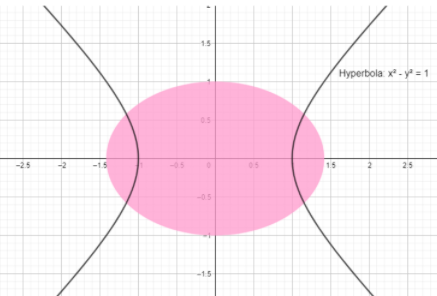Question
Question: An ellipse intersects the hyperbola \(2{{x}^{2}}-2{{y}^{2}}=1\) orthogonally. The eccentricity of th...
An ellipse intersects the hyperbola 2x2−2y2=1 orthogonally. The eccentricity of the ellipse is reciprocal of that of the hyperbola. If the axes of the ellipse are along the coordinate axes, then
(This question has multiple correct options)
(a) equation of ellipse is x2+2y2=2
(b) the foci of the ellipse are (±1, 0)
(c) equation of ellipse is x2+2y2=4
(d) the foci of ellipse are (±2,0)
Solution
To understand the question better, we shall draw the figure of the hyperbola given to use. We shall also draw a general ellipse. It is given that the axes of the ellipse are coordinate axes. This means the center of the ellipse is the origin (0, 0). It is given that ellipse and hyperbola intersect orthogonally. This means, at their point of intersection, tangents to the conics are perpendicular to each other. From the given conditions, we shall try to find the equation of the ellipse.
Complete step-by-step solution:
The hyperbola given to us is 2x2−2y2=1. We also know that the ellipse has coordinate axes as its major and minor axes.
Thus, we will draw a figure of the above-mentioned conics.

As we can see from the equation and figure, we know that the hyperbola is a rectangular hyperbola.
Thus, the eccentricity of the rectangular hyperbola is always 2.
It is given that the eccentricity of the ellipse is reciprocal as that of the hyperbola.
Thus, eccentricity e of ellipse is 21.
Now, as we know that the centre of the ellipse coincides with the origin (0, 0). The general equation of an ellipse centred at origin is a2x2+b2y2=1, where b2=a2(1−e2).
But e = 21
⇒b2=a2(1−21)⇒b2=2a2
Thus, the equation of the ellipse is a2x2+2a2y2=1⇒x2+2y2=a2.
Let (x1,y1) be the point of intersection of the ellipse x2+2y2=a2 and hyperbola 2x2−2y2=1.
The equation of the tangents at point (x1,y1) on different conics is as follows:
Ellipse: x1x+2y1y=a2 and slope: −2y1x1
Hyperbola: 2x1x−2y1y=1 and slope: y1x1
As the hyperbola and ellipse are orthogonal to each other, the tangents are perpendicular to each other. Thus, product of their slopes is -1.
⇒(−2y1x1)(y1x1)=−1⇒x12=2y12
If (x1,y1) is the point of intersection, it lies on the ellipse and on the hyperbola.
Thus x12+2y12=a2 and 2x12−2y12=1
Substitute x12=2y12 in 2x12−2y12=1
